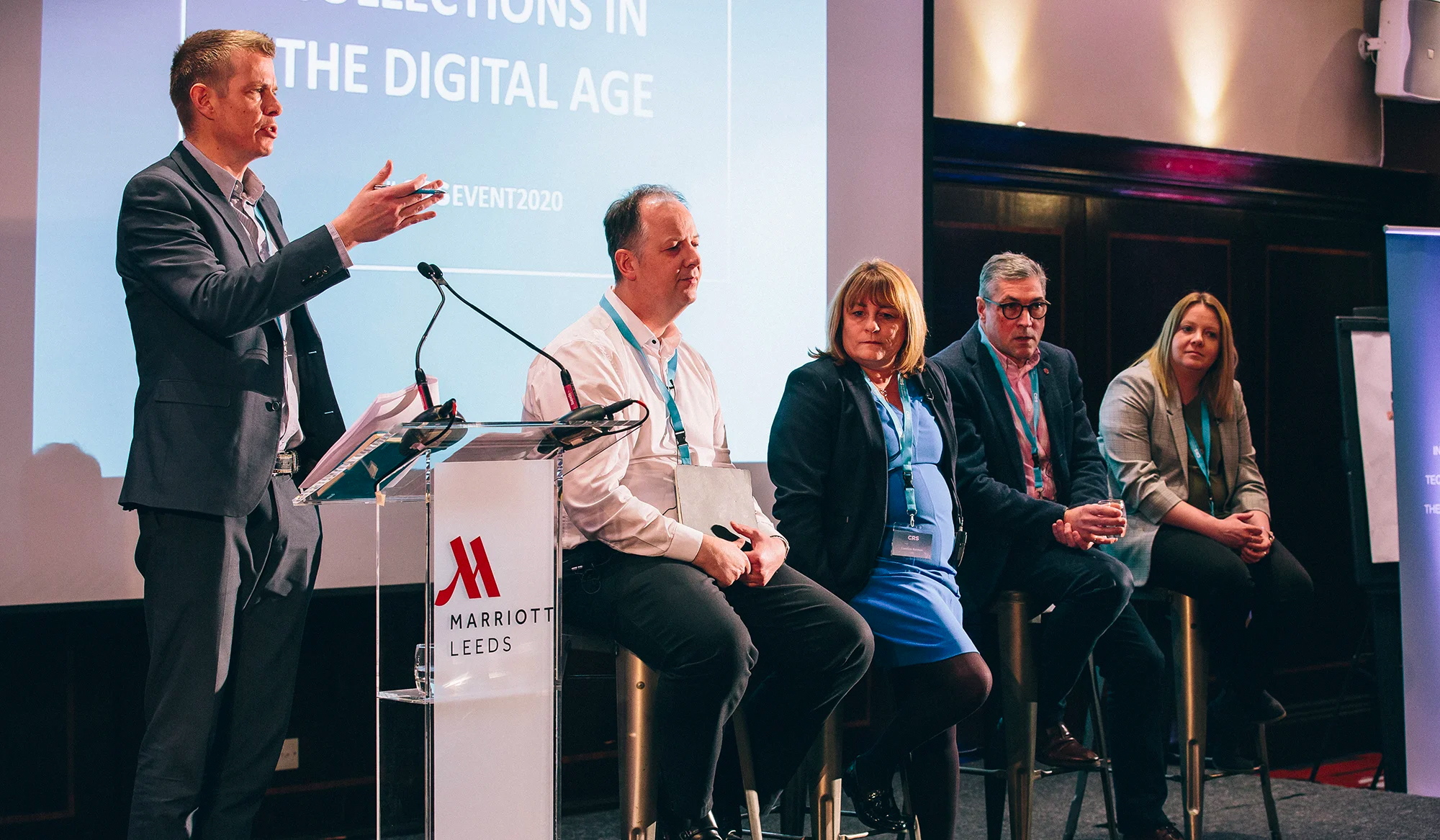Earlier this year coeo held their first-ever event looking to break the mould of tradition by directing the day away from standard subjects (Brexit, GDPR, wider economic issues) and confronting contemporary topics challenging the industry.
The most anticipated session of the day was the ‘The Biggest Question’ panel discussion. We invited a group of first-class industry experts to tackle some of the toughest questions facing this sector in the digital age.
In this final episode from ‘The Big Questions’ session, we fielded queries from the live industry audience and challenged our panellists with their questions. From dealing with vulnerable customers to offering each of their number one top tips in their tactical tool bag, this session had it all. And yes you’ve guessed it we’ve recorded it and uploaded it to The coeo Podcast, as well as typing up the transcripts for your reading pleasure below.
But before we get into the transcripts let’s introduce our first-class line up of panellists:
- Gary Grey (GG) Head of Collections at Spark Energy
- Caroline Burston (CB) Operations Director at coeo
- Caroline has worked in the Debt Collection industry since 1993 and gained extensive experience at several collection agencies and solicitors’ practices. Caroline is a well-known industry figure and brings extensive compliance experience and knowledge to coeo and is also a member of the prestigious Credit 500.
- Tony Gunderson (TG) 30 years + experience in financial services
- Tony has worked in the Financial Services Sector for the past 30 years at NatWest, Provident Financial Group and latterly as Director/Country Manager for Ferratum Group’s UK operation.
- Lisa Beeching (LB) Head of Supplier Management and Quality Assurance at 1st Central
- Lisa is currently Head of Supplier Management and Quality assurance at 1st Central Insurance and Technology managing key supplier relationships across 45 suppliers spanning all operational areas from sales through to claims.
Hosted by:
- James Squires (JS) Business Development Director at coeo
Roving Reporter:
- Ben Calvert (BC) Commercial Director at coeo
Interested in our services? to book a digital, self-isolation friendly, meeting.
Please enjoy!
JS: “Ben over to you”
BC: “Yes, we’ve got a few questions. We’re all wondering whether those stools look as uncomfortable as they look?” (audience laughs)
Collective Guest Panel Reply: (sarcastic) “They do!”
BC: “It was quite interesting there Gary that you touched on tracing because it hasn’t been mentioned too much.”
“We’ve got a question from Danny here that asks: ‘Has technology bypassed this element of recovery because it used to be big 10-15 years ago, in terms of contacting people and making sure they had the right addresses and then going after them’, do you think that using emails and mobile phone numbers that people don’t necessarily change, has kind of bypassed that speciality?”
GG: “I think it depends on your customer population. Within Spark Energy, you have a really transient population of customers moving from property to the next in a very short period of time.”
“I suppose the question I would ask back to Danny is: you know what, if you’ve exhausted your text message and emails what is it that you do have left? That’s when the trace element comes into it but as the first port of call contact details would be first and then you’d move onto trace and collect afterwards.”
BC: “Same question to Caroline?”
CB: “I think it varies by sector, obviously in the utility sector as Gary just said people move about and move about deliberately. Online lending, an online route to market people tend not to change their email addresses, so wherever they are moving to they’re taking those email addresses with them because they’ve got them linked to their twitter, their Instagram and all their other digital platforms.”
BC: “Thank you, before we move to some ‘vulnerable’ questions because there’s been a few of them fired in. We have a question from Jane Shaw, she asks: ‘Do you think it’s now more likely for won’t pays to contact us now and throw in buzz words to try and avoid payment? It may be a cynical view but I’m sure we’ll have an answer to that.
LB: “Absolutely I think there is an awful lot of messaging, there tends to be more on the text messages and the short sweet type emails that allow us to judge them as not particularly vulnerable but we’ll still have a look where it’s a very short sentence with the word stressed thrown it three times. Absolutely, it’s you’re stressing me out because you’ve sent me a text message. That would be your response. Absolutely I agree.”
GG: “I think while I worked in financial services and we look at things like the ability to pay and obviously we had quite a strong FCA focus, you’d probably see key words be mentioned more often.”
“Whilst in utilities we’ve got an FCA type focus moving across to the utility sector where they’re starting to talk about the ability to pay. So, I’m expecting a similar outcome as a result, unfortunately.”
BC: “I think some of Paul’s presentation this afternoon covers some of the aspects of that, so we’ll look forward to that one.”
“Going back to the vulnerable customer questions, some of the audience are looking for some actual practical advice on dealing with customers. So, if anyone could share any tactics you use rather than an overall strategy.”
TG: “I think it’s what type of vulnerability we’re talking about. So, if its financial distress then that should be reasonably straight forward to check and even more so going forward with the likes of open banking. Obviously you can use bureau information at the moment.”
“I think in terms of some of the other types of vulnerability, health again is another thing depending on the health problem which can be validated to some extent, you’ve got to do it sensitively, but you still can validate it.”
“Your more problematic areas are mental health issues, where you’ve probably just got to make judgement calls based on the history of the account, your ability to speak to that person or whether they’re going to put you on to somebody else who’s going to explain what that person’s problem is. So, one of the tactics you may use is actively asking permission to speak to somebody else, a friend, a family member etc.”
“In other cases, there are different types of information that can be validated and I would encourage people where it’s appropriate to validate what people are saying, because straight away that gives them the choice to be able to either do that or back off and say well I haven’t lost my job so I can’t use that now because you’ve asked me to prove that.”
“I think that’s always been the case, to be honest. I think in reality now it’s just been given a different label and the regulator sort of expecting a little more due diligence from you as an individual company.”
“So, I don’t think a great deal changed but except maybe how you go about it and that you do it in a proper way.”
GG: “I agree completely and what I’d add is if you have a customer that has a vulnerability after a certain period of time go back to that customer and see whether their circumstances have changed. Make sure you don’t exacerbate a pre-existing issue obviously, be careful what you say and do, but don’t think that you can’t go back to that customer in ‘X’ period and not have another conversation with them to ask are you in work now?”
BC: “One of the other questions asks about ‘how coeo apply breathing space and payment breaks?’ So, following on from Gary, how does that lead into a practical strategy for coeo, how do coeo do that Caroline?
CB: “So we apply our ‘four beds’, we have our own area where all the customers who have the financial breathing space or non-financial breathing space, we’ll actually ring-fence them outside of the main collections process.”
“We have a whole series of systems and platforms that allows us to communicate with the customer or with the customer’s appointed third party, or with the debt management company that links right from whether the customer tells us over the telephone or tells us this via the website or whatever platform. We’ll acknowledge we’re dealing with them and deal straight with the appointed parties.”
“We have a process that once the account has come off breathing space will fall into a specialist team, that will look after those customers rather than go ‘right here’s your 35 days’ and bang straight back into collections. So, it’s all ring-fenced and dealt with separately.”
BC: “Great, one of the first questions that came in and I think it’s a good one, I’m going to cut it down from instead of the three most important factors to having a good strong compliant collections performance. Maybe you could all just give us your number one top tip?”
TG: “I would say people have got to be well trained and know the guidelines they’re working to. That encompasses a lot, it’s key! If you haven’t got well-trained staff then they’re going to make mistakes and are going to get you in trouble.”
GG: “I agree and on top of that I’d probably add reporting and oversight. Having a good view of your customer base, understand where your key areas are and proactively managing those customers.”
LB: “From an outsourced point of view it’s the partnership, making sure what creates that debt, making sure you can have those meaningful conversations, and that we’ve got a relationship that’s close enough and can ask: is this collections strategy working? Is it not? It’s about keeping that partnership alive and fresh.”
BC: “I think that’s it, thank you!”
CB: “Can we get down now?”
JS: “Yes, it’s a really top job that and thank you so much for all of the panel, it’s been really great.”
Final Words from coeo
Thanks for taking the time to either listen to our podcast and/or read through this post. Check back with us soon as we’re looking to release further podcast content answering ‘The Biggest Questions’ in Collections.





![3 Improvements From Our Continuous Improvement Programme That Have Created Action in Collections [VLOG]](https://crscorporate.co.uk/wp-content/uploads/2022/10/Screenshot-2021-03-09-at-17.55.52-1536x751-1.png)

![coeo UK and AJJB Law [VLOG]](https://crscorporate.co.uk/wp-content/uploads/2022/10/Screenshot-2021-03-09-at-18.04.57-1536x818-1.png)
![The Utilities Industry And coeo UK [VLOG]](https://crscorporate.co.uk/wp-content/uploads/2022/10/Screenshot-2021-06-04-at-09.51.39-min.png)
![The Credit Finance Industry And coeo [VLOG]](https://crscorporate.co.uk/wp-content/uploads/2022/10/Screenshot-2021-08-31-at-10.51.59.png)
